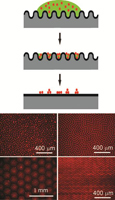
Wrinkling, buckling, and creasing
phenomena in synthetic and natural materials represents an opportunity to guide
the placement of nanostructures that enhance the optical, mechanical, and/or
electronic properties of materials.
Working in the Materials Research Science and Engineering Center on
Polymers at UMass Amherst, Crosby discovered that reversible wrinkling can
guide colloidal and nanoparticle assembly into well-ordered patterns across
macroscopic length scales. Due to the sinusoidal shape of top-constrained,
swelling-induced wrinkling, the deposition of fluorescent polystyrene (PS)
colloids occurs selectively in the
wrinkle patterns during solvent evaporation. After complete evaporation of
solvent, these colloidal assemblies are embossed as the surface snaps back to
the smooth state (top schematic). A key
advantage of this process is the ability to tune the assembly pattern by the
solubility of the dispersing solvent in the wrinkled substrate. Solvent choice controls the applied strain
that causes wrinkling, and the extent of strain beyond the critical value
dictates the specific morphology obtained (bottom schematic).